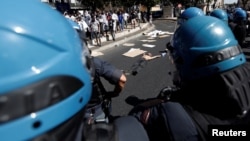Public sentiment toward immigrants continues to sour across Europe, prompting authorities to respond with decisive, sometimes violent, action.
An example occurred last week in Rome, when Italian police forcibly evicted hundreds of refugees from a building near the Piazza Indipendenza.
Police used a water cannon and beat people with batons, resulting in 13 people being treated for injuries at the scene and four hospitalizations, according to Doctors Without Borders in Italy. The force was necessary, police said, to defend themselves against rocks and gas canisters hurled by the refugees.
Following an international outcry, Rome’s city council said Friday it will allow 40 refugees — mostly children, elderly and people with disabilities — to stay in the building for six months; but, hundreds of others remain homeless, and thousands of recent arrivals throughout Italy continue to struggle to integrate with the society.
Violent eviction
An evictee interviewed by VOA’s Amharic Service described the chaotic scene as police forced refugees out of the building.
“I was running with everyone, and I was in front of the men so that they wouldn’t beat them, and then two police hit me,” she said. The woman says she was beaten on her hands, back and torso as she tried to protect another evictee.
“And then they hit me on my head, and I didn’t know what was going on,” she says. “When I tried to run, I got dizzy and fell because of the spraying water.”
An estimated 800 people, mostly Eritreans and Ethiopians, were living inside the building, and most fled when authorities arrived. Several hundred people stayed outside to protest, and about 100 people, mostly women, children and those with disabilities, remained inside. They were cleared out by authorities at 6 a.m. local time the following day.
Police said those evicted were illegally squatting. Immigrants had been occupying the building since 2013.
Calls for accountability
“Italian authorities need to ask hard questions about this shocking eviction and, in particular, whether the force used by police was necessary and proportionate,” said Judith Sunderland, associate director for Human Rights Watch’s Europe and Central Asia division. “Using police in riot gear to force vulnerable people out of their homes with little warning and nowhere to go is just about the opposite of how things should be handled,” she said.
Laetitia Bader, a researcher at Human Rights Watch, said Italian courts had first ordered the eviction in December 2016, and the refugees had been warned that it would take place five days prior to the police action.
The temporary housing offered by authorities, however, was considered substandard by the refugees and far from the city center, Bader said, adding that the government has a legal responsibility to provide housing to the displaced.
“Our concern is both that the notification was very abrupt [and] that [insufficient]... accommodation has been offered to these individuals,” she told VOA. “It's absolutely key that the government looks into and investigates the abusive police action.”
Negative sentiment
In Italy, public opinion toward refugees has grown increasingly hostile.
According to research published by Pew last September, 53 percent of Italians think diversity makes their country a worse place to live, and 77 disapprove of the EU’s handling of refugees. Sixty percent of Italians think refugees will increase domestic terrorism.
Politicians across the country have seized on this sentiment, often running on overtly anti-immigrant platforms. In June, center-right parties were decisive in local races, winning mayoral elections in 15 cities, according to The Guardian newspaper.
Italy’s burden and responsibility
Italians have seen record numbers of refugees reach their shores in recent years. At the end of 2016, Italy hosted nearly a quarter million “persons of concern,” including about 150,000 refugees and about 100,000 asylum-seekers, according to the U.N.’s refugee agency.
Despite its prominence as a point of entry into Europe, Italy hosts fewer persons of concern than both France, where more than 300,000 refugees live, and Germany, home to nearly 700,000 refugees and well over a half-million asylum seekers.
Italy has 20 million fewer people than does Germany, but hosts three times fewer persons of concern per capita.
It’s also processing far fewer asylum-seekers. In 2015 and 2016, 45 percent of asylum applications were handled in Germany, compared to 8 percent in Italy.
Within the country, some regions have been far more active in hosting refugees. Last summer, Italian newspaper La Stampa reported that just a quarter of the country’s 8,000 municipalities currently host migrants on humanitarian grounds.
In Rome, an Ethiopian woman interviewed by VOA’s Amharic Service last Friday said many of those evicted from the building are now sleeping on the streets.
She said they plan to continue protesting their treatment by Italian police. “They don’t have any respect for us. They think black people are flies and donkeys, and they are saying, 'We don’t care if you die,'" she said.








